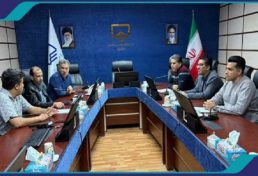 همایش های بین المللی
همایش های بین المللی مجموعه همایش های بین المللی ISPRS، مهر ۹۸
مجموعه همایش های بین المللی ISPRS، مهر ۹۸ برگزار می شود.
به گزارش پایگاه خبری مهندسین نیوز _ مرجع اخبار نظام مهندسی کشور،سطح برگزاری: بین المللی
مکان برگزاري: تهران – دانشگاه تهران
تاريخ برگزاري: ۲۰ الی ۲۲ مهر ۱۳۹۸
آخرين مهلت ارسال چکیده مقالات: ۲۱ فروردین ۹۸
اعلام نتایج داوری چکیده مقالات: ۱ خرداد ۹۸
آخرين مهلت ارسال اصل مقالات: ۱۹ تیر ۹۸
اعلام نتایج داوری اصل مقالات: ۲۰ مرداد ۹۸
دبیر علمی کنفرانس: دکتر محمد سعادت سرشت
دبیر اجرایی کنفرانس: دکتر پرهام پهلوانی
تلفن تماس با دبيرخانه: ۶۱۱۱۴۲۴۸-۰۲۱
وب سايت همايش: geospatialconf2019.ut.ac.ir
ایمیل: geospatial.conf[at]ut.ac.ir
مجموعه همایش های بین المللی ISPRS
Acquisition, storage, modeling and analysis of spatial data and information
Geospatial Information Systems
- Multi-dimensional modelling, analysis and visualization
- Spatial decision support systems and multi-criteria decision making
- Geospatial simulation and modeling
- Spatio-temporal data mining and knowledge discovery
- Spatial optimization and computational intelligence
- Spatial data quality and uncertainty assessment
- Location-based services, geospatial services and real-time applications
- Indoor and outdoor navigation, routing and way finding
- Spatial movement data analysis
- Geospatial information for smart cities and smart environment
- Geosensors networks and sensor Web
- Cartography, generalization and multi-scale representation
- Spatial cognition and spatial linguistics
- Spatial semantics and spatio-temporal ontologies
- Ubiquitous geospatial information systems
- Volunteered geographic information, crowdsourcing and public participatory GIS
- Spatial data structures and algorithms
- Spatial Big data management
- Building information management (BIM)
- Spatio-temporal data modeling, analysis and acquisition techniques
- Land administration, spatial data infrastructures and spatially-enabled government
- Interoperability and standards
Remote Sensing and Photogrammetry
- Airborne, terrestrial and mobile mapping
- Unmanned vehicle systems for geomatics
- Laser scanning for 3D surveying and mapping
- SAR image analysis, modeling and techniques
- POL and POLInSAR techniques and applications
- Digital terrain modeling and analysis
- Sensors and methods of DEM generation
- Feature extraction/selection and dimension reduction in hyperspectral images
- Image segmentation, object detection and recognition
- Target detection and unmixing in hyperspectral images
- Feature extraction and information retrieval from SAR and hyperspectral images
- Image and spatial data fusion
- Close range photogrammetry
- ۳D reconstruction and point cloud processing
- Virtual and augmented reality
- Tomography and 3D mapping
- Satellite oceanography
Geodesy
- Geodetic sensors and 3D measurements
- Relative satellite positioning
- Recent advances in modeling time-varying gravity field
- Geodetic reference frames
- Advances in earthquake source imaging using geodetic and seismic data
- Geodesy on large construction: monitoring of structures and system analysis
- Imaging geodesy and GPS for tectonic and non-tectonic deformation analysis
- Modeling atmospheric effects in geodetic observations
- Sensor technology and geodetic meteorology
Spatial information and earth observation for environmental monitoring, natural hazards, and disaster management
- Earth observation missions for monitoring environmental changes at local, regional and global scales
- Monitoring and modeling land use and land cover changes
- Remote sensing and GIS to support the emergency management
- Geoinformation to support early warning in cases of natural hazards
- Remote sensing of changes in snow and ice, frozen ground, ice sheets and glaciers and arctic water sea ice
- Photogrammetry and remote Sensing for dynamic vulnerability and recovery monitoring
- Desertification, deforestation, flood, earthquake, landslide vulnerability assessment
- Climate-induced hazards mapping and vulnerability assessment
- Modeling and analyzing of impacts from sea level rise
- Integration of remote sensing and GIS for predicting, monitoring and responding to hydro-meteorological and geophysical extremes
- Spatiotemporal modeling of landscape dynamics
- Quality assurance for environmental change databases
- New earth observation systems for natural hazard monitoring
- Geosensor networks for environmental monitoring
- UAV systems for hazard mapping and damage assessment
- Laser scanning for indoors and outdoor mapping and search and rescue simulations
- Web based multidimensional GIS for disaster risk management
- Multi-sensor fusion/integration for monitoring marine disasters
- Integrated coastal zone management (ICZM) modeling and monitoring
- Mobile mapping for transportation emergency response
- New geospatial technologies in early warning, forecasting and monitoring of natural hazard chains
- Public participation GIS for disaster preparedness and planning
- Foggy weather/heavy rain, impact on quality of life (e.g., car accidents)
- Red tide, impact on marine life and policy management
- Sand twisters and rigorous winds
- Geospatial modeling of environmental and air pollution
- Geospatial big data for environmental modeling
- Energy management using geospatial modeling
- Precise agriculture using remote sensing and GIS
- Terrestrial and sea surface thermal mapping
- Natural resource management using remote sensing and GIS integration
- Oil and gas potential mapping using remote sensing and GIS
- Rapid mapping for environmental applications and disaster management
- Mapping of settlement patterns for urbanization monitoring
- Agricultural mapping and monitoring
- Vegetation and crops monitoring and growth
- Forest classification and monitoring
منبع: کنفرانس یاب
مشاهده منابع آزمون نظام مهندسی
مباحث آزمون نظام مهندسی تاسیسات برقی


























لیست نظرات